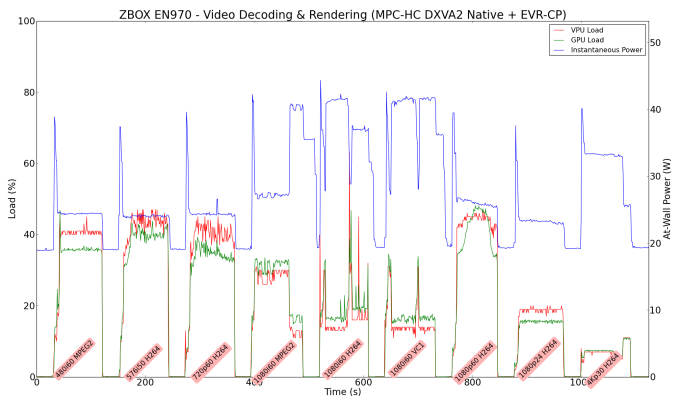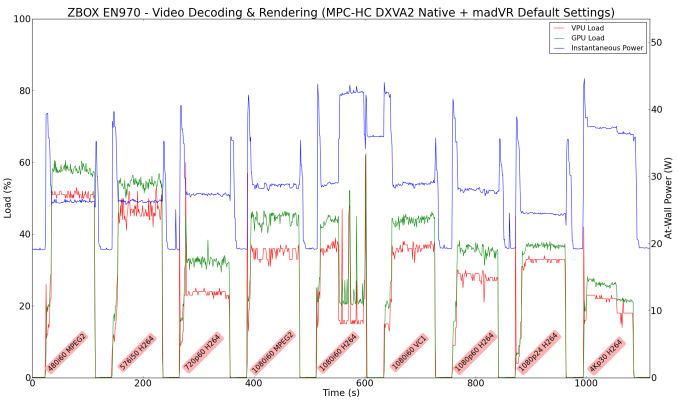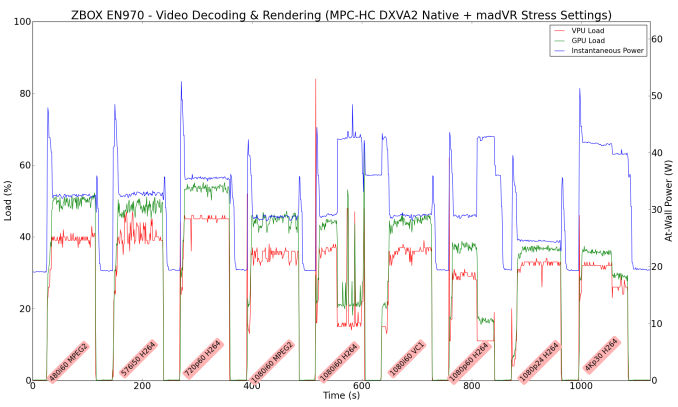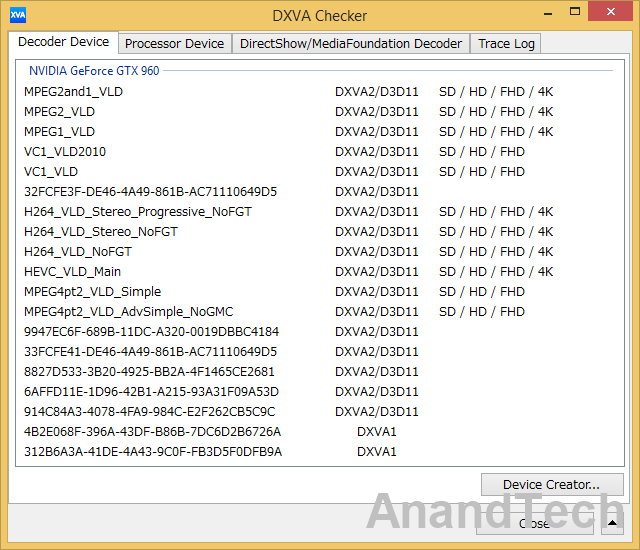Zotac ZBOX MAGNUS EN970 Review - A Gaming mini-PC Done Right
by Ganesh T S on September 28, 2015 8:00 AM ESTHTPC Credentials
Despite being actively cooled, I was pleasantly surprised by the noise profile of the system. The fans have variable rotational speeds, and in general, for most media related activities, the fan noise is minimal. I would go as far to say that the noise is probably the lowest amongst all the gaming mini-PCs that we have evaluated.
Refresh Rate Accurancy
Starting with Haswell, Intel, AMD and NVIDIA have been on par with respect to display refresh rate accuracy. The most important refresh rate for videophiles is obviously 23.976 Hz (the 23 Hz setting). The Zotac ZBOX MAGNUS EN970 does not have the same out-of-the-box accuracy possessed by Intel and AMD. However, NVIDIA also allows for setting custom resolutions and refresh rates.
The gallery below presents some of the other refresh rates that we tested out. The first statistic in madVR's OSD indicates the display refresh rate.
Network Streaming Efficiency
Evaluation of OTT playback efficiency was done by playing back our standard YouTube test stream and five minutes from our standard Netflix test title. Using HTML5, the YouTube stream plays back a 720p encoding. Since YouTube now defaults to HTML5 for video playback, we have stopped evaluating Adobe Flash acceleration. Note that only NVIDIA exposes GPU and VPU loads separately. Both Intel and AMD bundle the decoder load along with the GPU load. The following two graphs show the power consumption at the wall for playback of the HTML5 stream in Mozilla Firefox (v 41.0).

GPU load and VPU load were around 16.01% and 21.42% for the YouTube HTML5 stream.GPU load in the steady state for the Netflix streaming case was 5.88% and the VPU load was 4.36%.
Netflix streaming evaluation was done using the Windows 8.1 Netflix app. Manual stream selection is available (Ctrl-Alt-Shift-S) and debug information / statistics can also be viewed (Ctrl-Alt-Shift-D). Statistics collected for the YouTube streaming experiment were also collected here.

Decoding and Rendering Benchmarks
In order to evaluate local file playback, we concentrate on EVR-CP and madVR. We already know that EVR works quite well even with the Intel IGP for our test streams.
In our earlier reviews, we focused on presenting the GPU loading and power consumption at the wall in a table (with problematic streams in bold). Starting with the Broadwell NUC review, we decided to represent the GPU load and power consumption in a graph with dual Y-axes. Nine different test streams of 90 seconds each were played back with a gap of 30 seconds between each of them. The characteristics of each stream are annotated at the bottom of the graph. Note that the GPU usage is graphed in red and needs to be considered against the left axis, while the at-wall power consumption is graphed in green and needs to be considered against the right axis.
Frame drops are evident whenever the GPU load consistently stays above the 85 - 90% mark. An important aspect to note here for NVIDIA GPUs is that the load reported doesn't take into account the GPU clock. For example, the 4Kp30 clip in the EVR-CP mode: Initially, the GPU and VPU operate at higher clocks, resulting in the reported load being 7 - 8% and the power consumption being around 34W. However, later on towards the end of the stream, the load jumps up to around 12%, but the power consumption is now only around 25 W. Essentially, the power consumption at the wall is the real metric of efficiency for decode and playback. As long as the GPU load stays below the 85 - 90% mark, frame drops don't occur.
EVR-CP and madVR Defaults don't present any challenges to the GTX 960
Since the GTX 960 is a powerful GPU, we evaluated madVR with both default and stress settings. The 'madVR stress settings' was configured with the upscaling algorithms set to Jinc 3-tap with anti-ringing activated and the downscaling algorithm set to Lanczos 3-tap, again with anti-ringing activated.
The ZBOX MAGNUS EN970 was able to handle the madVR stress configuration without any issues.
Moving on to codec support, the GTX 970M / GM204 is a known quantity with regards to the scope of supported hardware accelerated codecs.
There is no HEVC_VLD_Main10 support. This is a bit disappointing since the real desktop GTX 960 supports Main10 decoding in hardware. Other than that aspect, the ZBOX MAGNUS EN970 actually makes for a reasonably power-efficient madVR-capable HTPC.


















88 Comments
View All Comments
krystyin - Monday, September 28, 2015 - link
It is the exact same box - except you can get it one whole month early.YukaKun - Monday, September 28, 2015 - link
I love the idea and concept, but I think it's still far from perfect execution on 2 accounts:1.- They could compromise an inch or less for height and put a beefier CPU in there without sacrificing a lot of space, but giving a HUGE performance and life longevity boost.
2.- Sound does not seem to be something they cares much about. For that price range and fighting for Living Room space, they need to show more sound options and connectivity. Good on the HDMI front, but I did not see an optical nor RCA SPDIF connector. Plus, no DP can be forgiven, but still hurts IMO.
I think the price is also high, but if this delivers in acoustics and brute performance in such a nice small package, it justifies the price. Most great notebooks that come close to this are over 1K.
Cheers!
wintermute000 - Tuesday, September 29, 2015 - link
Also, for this price I'd want HDCP 2.2 and 4k/60fps hardware HEVC10.For this scenario you'd almost say a GTX960 based card would have been better for the HEVC10 and HDCP 2.2 (than a cut down GTX970) - even if you give up a few frames, I would not expect a 1k HTPC to lack ANY HTPC features
abhaxus - Monday, September 28, 2015 - link
Another article with a scrolling mobile ad. Closing after the first page. AT is fast losing any relevance it had before the loss of Anand and the buyout. Late coverage on important releases, less filler content, poor news section, embarrassing advertising. AT was the reason I uninstalled AdBlock years ago because I wanted to support the site and others like it. I remember when you offered instructions on the site for how to turn off the annoying word highlight ads on your help page. Now this. Just sad.vortexmak - Monday, September 28, 2015 - link
All the disadvantages of a laptop with none of the mobilitylmcd - Tuesday, September 29, 2015 - link
Not true -- the mobility counts for frequent long-distant mobility. Really interesting as a college student on a budget.HigherState - Monday, September 28, 2015 - link
I cannot get past price/performance. A PC in a Silverstone mini-itx case (or equivalent) can get you the same performance for lower price. "Oh the box isn't as small as my appleTV :( "........please. Maybe I'm not the target audience.meacupla - Tuesday, September 29, 2015 - link
The story becomes different when you want to lug around a gaming PC in a suitcase, especially carry-on.SpartyOn - Monday, September 28, 2015 - link
These small gaming NUCs do not compute for me... Why pay the SFF premium to get essentially a laptop in a box - without the mobility? If you use Steam for your games, there is ABSOLUTELY NO REASON to buy a SFF PC anymore.Just buy/build whatever size computer you want - I use mITX because I actually do take my box to other people's houses, but any size box is fine - and leave it in one location in your home. Then just buy a compute stick or build a cheap NUC to stream games from the main rig to these inexpensive living room PCs.
For $978 you could build a nice desktop GTX 970 system - immensely more powerful that the reviewed machine - and still have money left over for an inexpensive streaming solution. So not only do you get a better gaming computer, but you still have an HTPC to boot. Win-win.
Maybe this serves LAN gamers who need an even smaller box than an mITX rig? I dunno, I have no trouble carting my mITX around with a full-size desktop card and if I did, I'd still just buy a laptop if I needed additional portability.
10 years ago these things would have been awesome. Now their just a niche product for people who don't know any better.
jordanclock - Monday, September 28, 2015 - link
These absolutely have a purpose. It's in the living room. SFF PCs fit the same niche as consoles. They're small, relatively quiet and perform fine at 1080p. They're not meant for mobility and you won't get the same feature set for a similar price in a full ATX PC, unless you want something much louder and harder to fit in an entertainment center.Just because these kinds of PCs aren't for you, isn't to say they have no reason to exist.